Molecular orbital theory - Study guides, Class notes & Summaries
Looking for the best study guides, study notes and summaries about Molecular orbital theory? On this page you'll find 284 study documents about Molecular orbital theory.
Page 4 out of 284 results
Sort by
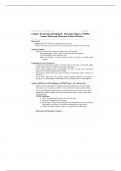
-
Chem 031 Chemical Bonding Notes
- Class notes • 17 pages • 2024
- Available in package deal
-
- $10.99
- + learn more
This is a comprehensive and detailed note on Chapter 10 notes/summary on bonding II which includes molecular shapes, valence bond theory and molecular orbital theory. To your success in academics!!
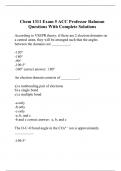
-
Chem 1311 Exam 5 ACC Professor Rahman Questions With Complete Solutions
- Exam (elaborations) • 25 pages • 2023
-
Available in package deal
-
- $13.99
- + learn more
According to VSEPR theory, if there are 2 electron domains on a central atom, they will be arranged such that the angles between the domains are __________. -120° -180° -90° -109.5° -360° correct answer: 180° An electron domain consists of __________. a) a nonbonding pair of electrons b) a single bond c) a multiple bond -a only -b only -c only -a, b, and c -b and c correct answer: a, b, and c The O-C-O bond angle in the CO₃²⁻ ion is approximately ______...

-
TEST BANK FOR ORGANIC CHEMISTRY WITH BIOLOGICAL TOPICS 6th EDITION ISBN : 9781260325294 ALL CHAPTERS INCLUDED.
- Exam (elaborations) • 957 pages • 2023
-
- $17.99
- + learn more
TEST BANK FOR ORGANIC CHEMISTRY WITH BIOLOGICAL TOPICS 6th EDITION ISBN : 9781260325294 ALL CHAPTERS INCLUDED. Chapter 1 1 MULTIPLE CHOICE QUESTIONS Topic: Atomic Orbitals 1. In quantum mechanics a node (nodal surface or plane) is: A) a place where Ψ is negative. B) a place where Ψ is positive. C) a place where Ψ = 0. D) a place where Ψ 2 is large. E) a place where Ψ 2 is negative. Ans: C Topic: Atomic Orbitals, Molecular Orbitals 2. When the 1s orbitals of two hydroge...
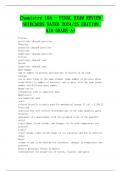
-
Chemistry 104 - FINAL EXAM REVIEW NOTECARDS RATED 2024/25 EDITION AID GRADE A+
- Exam (elaborations) • 7 pages • 2024
-
- $7.29
- + learn more
Protons positively charged particles Neutrons neutrally charged particles Electrons negatively charged particles Cations positively charged ions Anions negatively charged ions Mass Number sum of number of protons and neutrons in nucleus of an atom Isotope two or more forms of the same element (same number of protons) whose atoms differ in number of neutrons, and in mass, with the same atomic number and different mass number. Quantitative information such as numerical data Qualita...
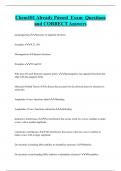
-
Chem101 Already Passed Exam Questions and CORRECT Answers
- Exam (elaborations) • 7 pages • 2024
-
- $7.99
- + learn more
paramagnetism presence of unpaired electrons Examples P, Ti, NO Diamagnetism paired electrons Examples N2 and O2 Why does O2 stick between magnetic poles? paramagnetic; has unpaired electrons that align with the magnetic field Molecular Orbital Theory a theory that accounts for the allowed states for electrons in molecules Amplitude of wave functions added Bonding
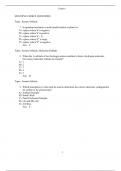
-
CHM 2210 Organic Chemistry TEST BANK
- Other • 956 pages • 2023
-
- $30.49
- + learn more
MULTIPLE CHOICE QUESTIONS Topic: Atomic Orbitals 1. In quantum mechanics a node (nodal surface or plane) is: A) a place where Ψ is negative. B) a place where Ψ is positive. C) a place where Ψ = 0. D) a place where Ψ2 is large. E) a place where Ψ2 is negative. Ans: C Topic: Atomic Orbitals, Molecular Orbitals 2. When the 1s orbitals of two hydrogen atoms combine to form a hydrogen molecule, how many molecular orbitals are formed? A) 1 B) 2 C) 3 D) 4 E) 5 Ans: B Topic: A...
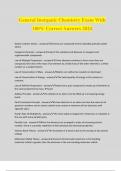
-
General Inorganic Chemistry Exam With 100% Correct Answers 2024
- Exam (elaborations) • 9 pages • 2024
- Available in package deal
-
- $11.49
- + learn more
General Inorganic Chemistry Exam With 100% Correct Answers 2024 Dalton's Atomic theory - answerElements are composed of tiny indivisible particles called atoms. Inorganic Chemistry - answerstudy of the synthesis and behavior in inorganic and organometallic compounds Law of Multiple Proportions - answerIf two elements combine to form more than one compound, the ratio of the mass of an element to a fixed mass of the other element is a whole number or a simple fraction. Law of Conservatio...
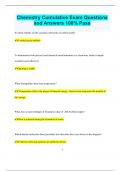
-
Chemistry Cumulative Exam Questions and Answers 100% Pass
- Exam (elaborations) • 10 pages • 2024
-
Available in package deal
-
- $9.99
- + learn more
Chemistry Cumulative Exam Questions and Answers 100% Pass In which orbitals are the outermost electrons of carbon found? s orbital and p orbitals To demonstrate both physical and chemical transformations in a classroom, which example would be most effective? Igniting a candle What distinguishes heat from temperature? Temperature reflects the degree of thermal energy, whereas heat represents the transfer of this energy. What does a water enthalpy of formation value of -285...
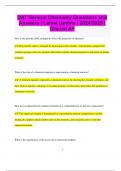
-
DAT General Chemistry Questions and Answers | Latest Update | 2024/2025 | Graded A+
- Exam (elaborations) • 30 pages • 2024
- Available in package deal
-
- $10.41
- + learn more
DAT General Chemistry Questions and Answers | Latest Update | 2024/2025 | Graded A+ How is the periodic table arranged to reflect the properties of elements? The periodic table is arranged by increasing atomic number, with elements grouped into columns (groups) and rows (periods) that reflect similar chemical properties and trends in atomic structure. What is the role of a chemical equation in representing a chemical reaction? A chemical equation represents a chemical reaction by...
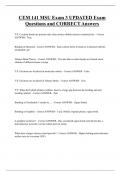
-
CEM 141 MSU Exam 3 UPDATED Exam Questions and CORRECT Answers
- Exam (elaborations) • 8 pages • 2024
-
- $7.99
- + learn more
CEM 141 MSU Exam 3 UPDATED Exam Questions and CORRECT Answers T/F: Covalent bonds are present only when atomic orbitals interact constructively. - Correct ANSWER- True. Binding in Diamond - Correct ANSWER- Each carbon forms 4 bonds to 4 identical carbons; tetrahedral; sp3 Valence Bond Theory - Correct ANSWER- The idea that covalent bonds are formed when orbitals of different atoms overlap. T/F: Electrons are localized in molecular orbital. - Correct ANSWER- False

Do you wonder why so many students wear nice clothes, have money to spare and enjoy tons of free time? Well, they sell on Stuvia! Imagine your study notes being downloaded a dozen times for $15 each. Every. Single. Day. Discover all about earning on Stuvia


